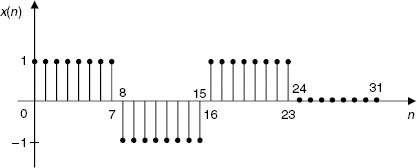COMPUTER EXERCISES
6.12. In this problem, we will study the filter banks that are based on the DFT. Use Eq. (6.39a) to implement a 2M-point DFT of x(n) given in Figure 6.31. Assume M = 8.
- Give the plots of |X(k)|.
- Plot the frequency response of the second- and third-channel analysis filters that are associated with the basis vectors h1(n) and h2(n).
- State whether the DFT filter bank is evenly stacked or oddly stacked.
6.13. In this problem, we will study the filter banks that are based on the DCT. Use Eq. (6.41a) to implement a M-point DCT of x(n) given in Figure 6.31. Assume M = 8.
- Give the plots of |X(k)|.
- Also plot the frequency response of the second and third channel analysis filters that are associated with the basis vectors h1(n) and h2(n).
- Plot the impulse response of h1(n) and see if it is symmetric.
- Is the DCT filter bank evenly stacked or oddly stacked?
6.14. In this problem, we will study the filter banks based on the MDCT.
- First, design a sine window, w(n) = sin[(2n + 1)π/4M] with M = 8.
- Check if the sine window satisfies the generalized perfect reconstruction conditions, i.e., Eqs. (6.28a) (6.28b).
- Next, design a MDCT analysis filter bank, hk(n), for 0 < k < 7.

Figure 6.31. Input signal, x(n), for Problems 6.12, 6.13, and 6.14.
- Plot both the impulse response and the frequency response of the analysis filters, h1(n) and h2(n).
- Compute the MDCT coefficients, X
Get Audio Signal Processing and Coding now with the O’Reilly learning platform.
O’Reilly members experience books, live events, courses curated by job role, and more from O’Reilly and nearly 200 top publishers.

